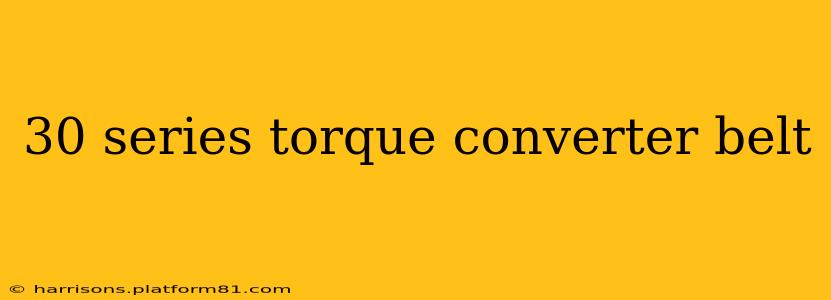Finding the right torque converter belt for your equipment is crucial for optimal performance and longevity. This guide focuses on 30 series torque converter belts, exploring their specifications, applications, and key considerations for selection and maintenance. Understanding these aspects will help you make informed decisions and avoid costly mistakes.
What is a 30 Series Torque Converter Belt?
A 30 series torque converter belt is a specific type of V-belt designed for use in torque converters, often found in heavy-duty equipment like tractors, combines, and other agricultural machinery. The "30 series" designation refers to its dimensions and specifications, including its width and overall length. These belts are engineered to withstand high torque loads and operate under demanding conditions. They are typically constructed from durable materials like high-strength rubber and fabric to ensure resilience and longevity.
What are the Key Specifications of a 30 Series Torque Converter Belt?
Several key specifications define a 30 series torque converter belt:
- Length: Measured in inches, this is a critical dimension determining the proper fit within the torque converter system. Incorrect length can lead to slippage or premature wear.
- Width: Also measured in inches, the width influences the belt's power transmission capacity. Wider belts generally handle higher torque loads.
- Top Width: The width of the belt at its top surface.
- Construction: The materials used in the belt's construction impact its durability and ability to withstand high loads and stress. This typically includes details about the rubber compound and reinforcement fabrics.
- Number of Ribs/Cogs: Some 30 series belts might feature multiple ribs or cogs, enhancing grip and power transfer.
How to Choose the Right 30 Series Torque Converter Belt?
Selecting the correct 30 series torque converter belt requires careful consideration of several factors:
- Manufacturer's Specifications: Always refer to your equipment's operator's manual for the recommended belt specifications, including part numbers and dimensions.
- Belt Length: Precise measurement of the existing belt or consulting the manufacturer's specifications is vital to ensure proper fit.
- Belt Width: Choosing the appropriate width is crucial for optimal power transfer and to avoid overloading the belt.
- Belt Material: Select a belt constructed from materials that can handle the specific operating conditions of your equipment.
What are the common causes of 30 series torque converter belt failure?
Several factors contribute to the premature failure of 30 series torque converter belts:
- Incorrect Belt Tension: Insufficient or excessive tension can lead to slippage and rapid wear.
- Misalignment: Improper alignment of the pulleys can cause uneven wear and stress on the belt.
- Overloading: Exceeding the belt's rated capacity can result in breakage or premature failure.
- Deterioration: Exposure to extreme temperatures, moisture, or chemicals can degrade the belt's material and reduce its lifespan.
- Contamination: Dirt, debris, or oil on the belt or pulleys can reduce grip and accelerate wear.
How often should a 30 series torque converter belt be replaced?
The frequency of replacement depends on usage, operating conditions, and the belt's condition. Regular inspection for cracks, fraying, glazing, or excessive wear is crucial. Manufacturers often recommend replacement intervals, which should be followed for optimal equipment performance. Visible damage or significant wear are clear indicators that replacement is necessary.
Where can I find replacement 30 series torque converter belts?
Replacement belts can be sourced from authorized dealers of your equipment's manufacturer, agricultural supply stores, and online retailers specializing in industrial belts. Always verify the belt's specifications before purchasing to ensure compatibility.
What are the signs of a worn 30 series torque converter belt?
Signs of a worn 30 series torque converter belt include:
- Cracks or tears in the belt surface: This indicates significant wear and potential failure.
- Fraying or glazing: These indicate excessive wear and reduced grip.
- Belt slippage: If the belt slips, it's not transferring power efficiently and needs replacement.
- Unusual noises: Loud squealing or whining noises during operation often indicate a worn or damaged belt.
- Visible wear: Uneven wear or excessive wear on specific sections of the belt indicates potential misalignment or other problems.
By understanding the specifications, selection criteria, and maintenance needs of 30 series torque converter belts, you can ensure the reliable operation of your equipment and avoid costly downtime. Remember always to consult your equipment's manual for specific recommendations.
